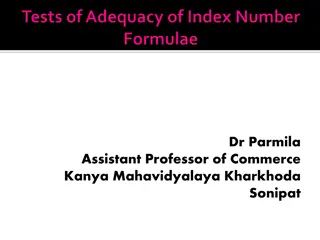
Significant Changes in California Property Tax Laws
Explore the impacts of Proposition 19 on property tax laws in California, including changes to inheritance rules and tax-saving programs. Discover how this constitutional amendment affects property transfers and tax assessments in the state.
Download Presentation

Please find below an Image/Link to download the presentation.
The content on the website is provided AS IS for your information and personal use only. It may not be sold, licensed, or shared on other websites without obtaining consent from the author. If you encounter any issues during the download, it is possible that the publisher has removed the file from their server.
You are allowed to download the files provided on this website for personal or commercial use, subject to the condition that they are used lawfully. All files are the property of their respective owners.
The content on the website is provided AS IS for your information and personal use only. It may not be sold, licensed, or shared on other websites without obtaining consent from the author.
E N D
Presentation Transcript
Real Property Transfers Real Property Transfers Post Proposition 19 Post Proposition 19
Proposition 13 Proposition 13 (officially named the People's Initiative to Limit Property Taxation) is an amendment of the Constitution of California enacted in 1978, by means of the initiative process. The initiative was approved by California voters on June 6, 1978. The most significant portion of the act is the first paragraph, which limits the tax rate for real estate: Section 1. (a) The maximum amount of any ad valorem tax on real property shall not exceed one percent (1%) of the full cash value of such property. The one percent (1%) tax to be collected by the counties and apportioned according to law to the districts within the counties.
Proposition 13 The proposition decreased property taxes by assessing values at their 1976 value and restricted annual increases of assessed value to an inflation factor, not to exceed 2% per year. It prohibits reassessment of a new base year value except in cases of (a) change in ownership, or (b) completion of new construction. These rules apply equally to all real estate, residential and commercial whether owned by individuals or corporations. The proposition has been called the "third rail" (meaning "untouchable subject") of California politics, and it is not popular politically for lawmakers to attempt to change it.
Proposition 19 On November 3, 2020, California voters approved Proposition 19, (officially named the Home Protection for Seniors, Severely Disabled, Families and Victims of Wildfire or Natural Disasters Act.) Proposition 19 is a constitutional amendment that limits people who inherit family properties from keeping the low property tax base unless they use the home as their primary residence, but it also allows homeowners who are over 55 years of age, disabled, or victims of a wildfire or natural disaster to transfer their assessed value of their primary home to a newly purchased or newly constructed replacement primary residence up to three times.
Proposition 19 The new law will make important changes to two existing statewide property tax saving programs: - Replace Proposition 58 (1986) and Proposition 193 (1996) by limiting parent- and-child transfer and grandparent-to-grandchild transfer exclusions - Effective 2/16/2021 - Replace Proposition 60 (1986) and Proposition 90 (1988) programs for home transfer by seniors and severely disabled persons - Effective 4/1/2021
What Hasnt Changed Using LLCs Proposition 19 primarily effects properties individually transferred, not properties held in entities. Transfers into an LLC or corporation do not constitute a change in ownership so long as the proportional interest in the property is exactly the same. So if Husband and Wife own a property 50-50 and transfer the property to an LLC in which they also own 50-50, no reassessment would occur.
What Hasnt Changed Using LLCs Transfers within entities. A transfer of fifty percent (50%) or less of any interest in a partnership, LLC or legal entity is generally not considered a change in ownership. The key for this exclusion is whether the transfer of partnership interests results in a change in controlling interest. For example, if I own 51% of an LLC that owns real estate and I buy out the other 49% interest owners, there is no change in ownership because there is no change in controlling interest.
Transfers of Real Property The California Revenue and Taxation Code defines a change in ownership as a transfer of a present interest in real property, including the beneficial use thereof, the value of which is substantially equal to the value of the fee interest. This expansive definition, clarified by other sections of the code and regulations, covers most common transfers, whether voluntary, involuntary, or by operation of law.
Transfers of Real Property When Does It Occur? The general rule is that the transfer of any interest in real property between a corporation, partnership, or other legal entity and a shareholder, partner, or any other person is a change in ownership. This general rule is applicable in arms-length transactions. If Person A and Corporation B have no relationship and Person A sells an interest in land to Corporation B, this is a change in ownership and the property will be reassessed. Likewise, if Corporation B later sells to Limited Liability Company C, there is another change in ownership.
Transfers of Real Property When Does It Occur? The exception to this rule is what is known as the proportional interest transfer change in ownership exclusion. There is no change in ownership in a transfer between individuals or entities that results solely in a change in the method of holding title to the real property and in which proportional ownership interests of the transferors and transferees . . . in each and every piece of real property transferred, remain the same after the transfer.
Transfers of Interest in Legal Entities The general rule is that the purchase or transfer of ownership interests in legal entities, such as corporate stock or partnership or limited liability company interests, shall not be deemed to constitute a transfer of the real property of the legal entity. Under this general rule, stock in a corporation can be bought and sold without characterizing that transaction as a change in ownership of the real property held by the corporation. There are two major exceptions to this rule. - - The first is for transfers that result in a change in control of the legal entity. The second is when original co-owners have cumulatively transferred more than 50% of their interest in the legal entity.
Change In Control Control of a legal entity exists when one person (or entity) directly or indirectly owns more than 50% of the legal entity. - For corporations, ownership means the voting stock. - For limited liability companies and partnerships, ownership means both capital and profit interests. When there is a change in control, there is a change in ownership and the real property held by the entity is reassessed.
Change In Control Example(s) Person A owns 55% of the voting stock of Corporation C, which owns real property. Person A sells all of his stock to Person B. There is a change in ownership in the underlying real property because of the change in control. Assume the same facts as the previous example, except that Corporation C does not directly own real property. Instead, Corporation C has a 60% capital and profit interest in a limited partnership that owns real property. When Person A sells all of his voting stock to Person B, Person B now indirectly has control of the limited partnership. This change in control means that there is a change in ownership of the underlying real property, and reassessment of the real property is proper.
Original Co-Owner Transfers An original co-owner is a person who gains an ownership interest in a legal entity following a proportional interest transfer. Regardless of whether there is a change in control, once the original co-owners cumulatively transfer more than 50% of the ownership interest in the legal entity, there is a change in control. There are several transfers that do not count as an original co-owner interest transfer: (1) transfers between spouses or between registered domestic partners, (2) transfers to or from a trust established for the trustor s benefit (or the benefit of the trustor s spouse or registered domestic partner), (3) a proportional interest transfer, and (4) transfers which have already been counted.
Reporting Change in Ownership or Control Changes in Ownership and/or Control are monitored by the State Board of Equalization. Whenever there is a change in control, the person or legal entity acquiring ownership control or the legal entity that has undergone a change in ownership must file the BOE-100-B, Statement of Change in Control and Ownership of Legal Entities (statement) with the Board of Equalization (BOE) within 90 days of the change in control or ownership. In addition, any legal entity is required to file a statement with the BOE within 90 days of the date of the BOE s request regardless of whether a change in control or ownership of the legal entity has occurred.
Things to Consider When considering transfers of interests in legal entities, it is also important to remember that common exclusions to the general change in ownership rule are not always applicable. - Transfers of real property between parents and children, as well as grandparents and grandchildren, are not considered changes in ownership under some circumstances. However, both the parent child and parent grandchild exclusions specifically do not apply to transfers of interests in legal entities.
Questions? Questions?






















